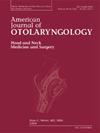Comparing the multi-disciplinary approach utilizing cognitive behavioral therapy and sound therapy to standard audiological treatment in chronic tinnitus patients: Impact on severity reduction and quality of life improvement
IF 1.7
4区 医学
Q2 OTORHINOLARYNGOLOGY
引用次数: 0
Abstract
Objective
To compare the impact of a multi-disciplinary approach utilizing Cognitive Behavioral Therapy (CBT) and Sound Therapy (ST) in chronic tinnitus patients.
Methods
The clinical data of 111 adult patients with chronic tinnitus were retrospectively analyzed. Patients were divided into the CBT + ST Group (CBT + ST, n = 55) and the Standard Group (standard therapy, n = 56). Baseline demographic characteristics, severity of tinnitus symptoms, audiometric measures, quality of life scores, treatment efficacy, and anxiety and depression scores were evaluated.
Results
Comparing with control, the CBT + ST group significantly reduced tinnitus severity scores, including Tinnitus Handicap Inventory, Tinnitus Functional Index, and Tinnitus Visual Analog Scale. Audiological measures revealed improved hearing thresholds and speech recognition in the CBT + ST group. CBT + ST also improved quality of life, with significant higher percentages of complete and partial treatment responses and lower anxiety and depression scores.
Conclusion
Multi-disciplinary approach utilizing CBT + ST effectively reduces tinnitus severity, improves quality of life, and enhances treatment efficacy.
认知行为疗法和声音疗法与标准听力学治疗慢性耳鸣患者的多学科方法比较:对严重程度降低和生活质量改善的影响
目的比较认知行为疗法(CBT)与声音疗法(ST)治疗慢性耳鸣的效果。方法回顾性分析111例成人慢性耳鸣患者的临床资料。患者分为CBT + ST组(CBT + ST, n = 55)和标准组(标准治疗,n = 56)。评估基线人口统计学特征、耳鸣症状严重程度、听力测量、生活质量评分、治疗疗效、焦虑和抑郁评分。结果与对照组相比,CBT + ST组显著降低了耳鸣严重程度评分,包括耳鸣障碍量表、耳鸣功能指数和耳鸣视觉模拟量表。听力学测量显示CBT + ST组的听力阈值和语音识别有所改善。CBT + ST也改善了生活质量,完全和部分治疗反应的百分比显著提高,焦虑和抑郁评分较低。结论CBT + ST多学科联合治疗可有效降低耳鸣严重程度,改善生活质量,提高治疗效果。
本文章由计算机程序翻译,如有差异,请以英文原文为准。
求助全文
约1分钟内获得全文
求助全文
来源期刊

American Journal of Otolaryngology
医学-耳鼻喉科学
CiteScore
4.40
自引率
4.00%
发文量
378
审稿时长
41 days
期刊介绍:
Be fully informed about developments in otology, neurotology, audiology, rhinology, allergy, laryngology, speech science, bronchoesophagology, facial plastic surgery, and head and neck surgery. Featured sections include original contributions, grand rounds, current reviews, case reports and socioeconomics.
 求助内容:
求助内容: 应助结果提醒方式:
应助结果提醒方式:


